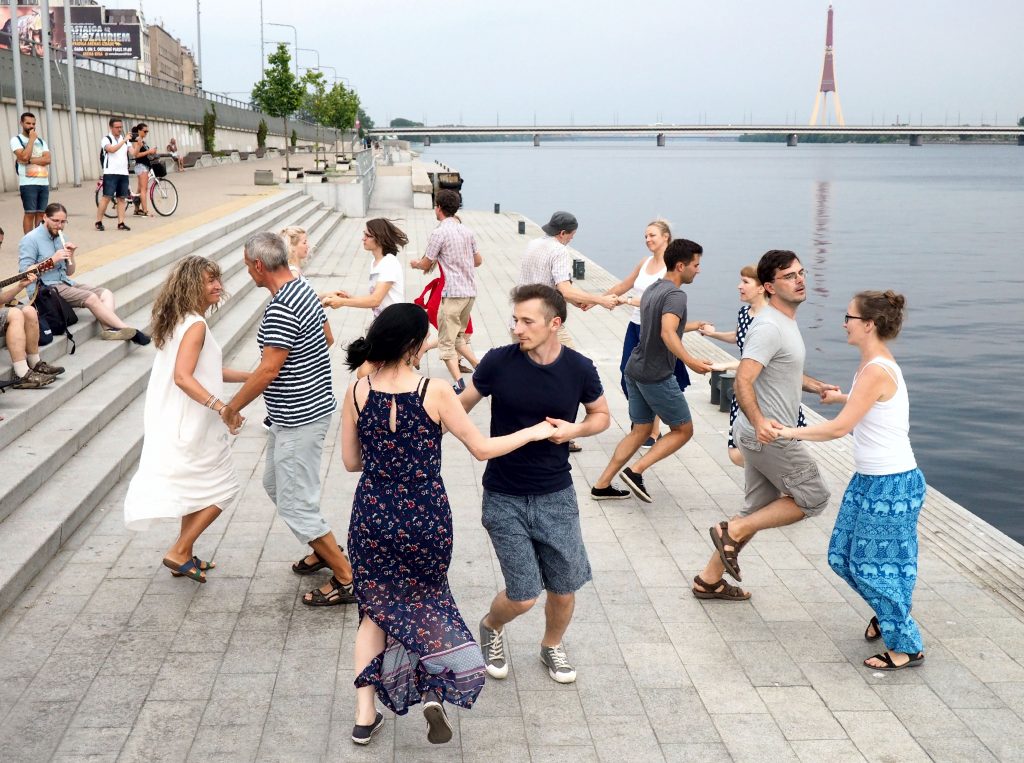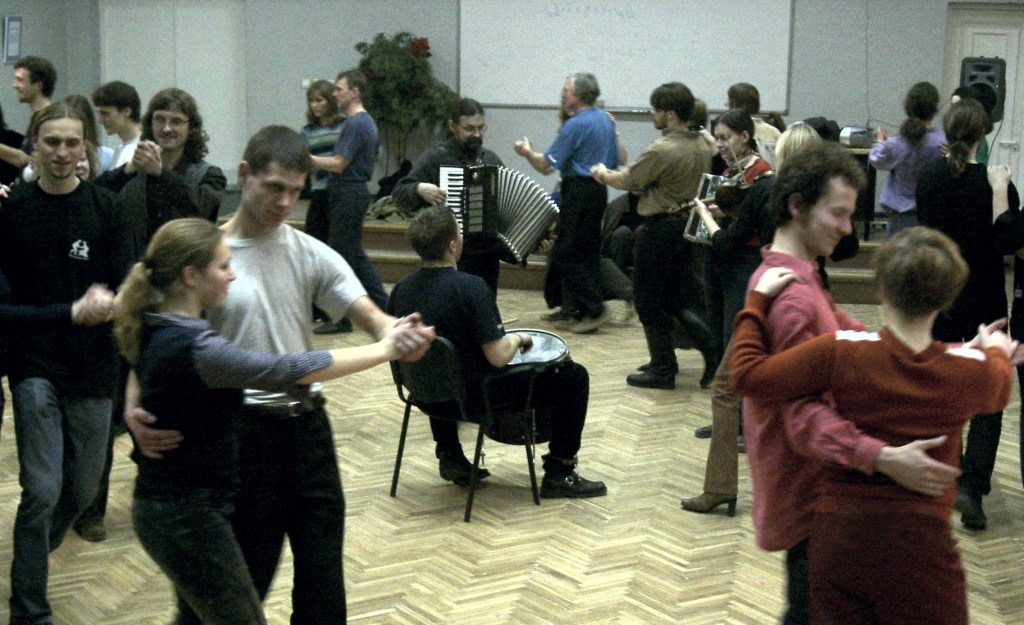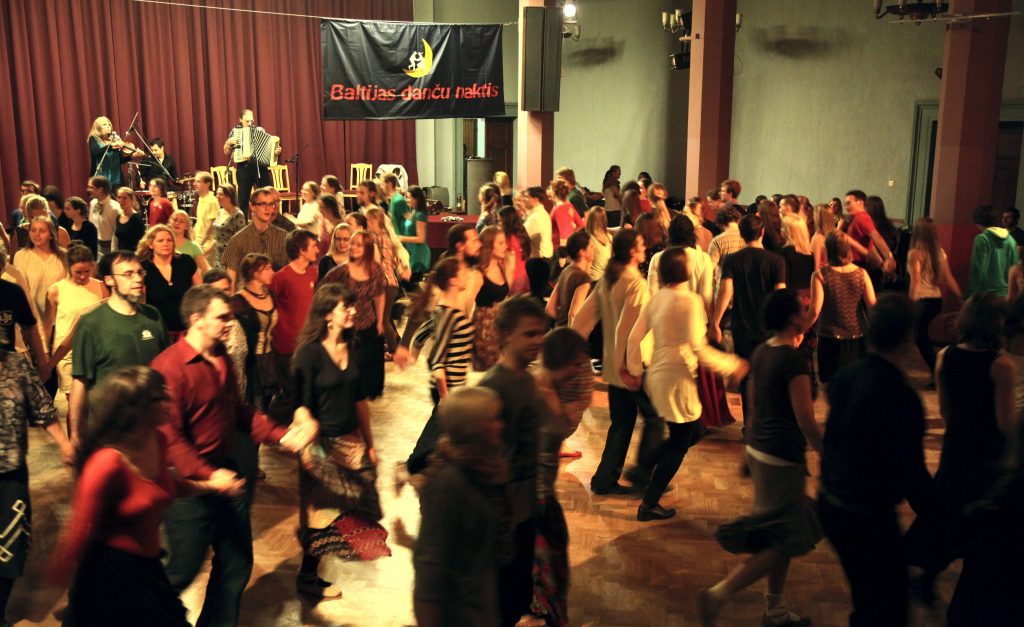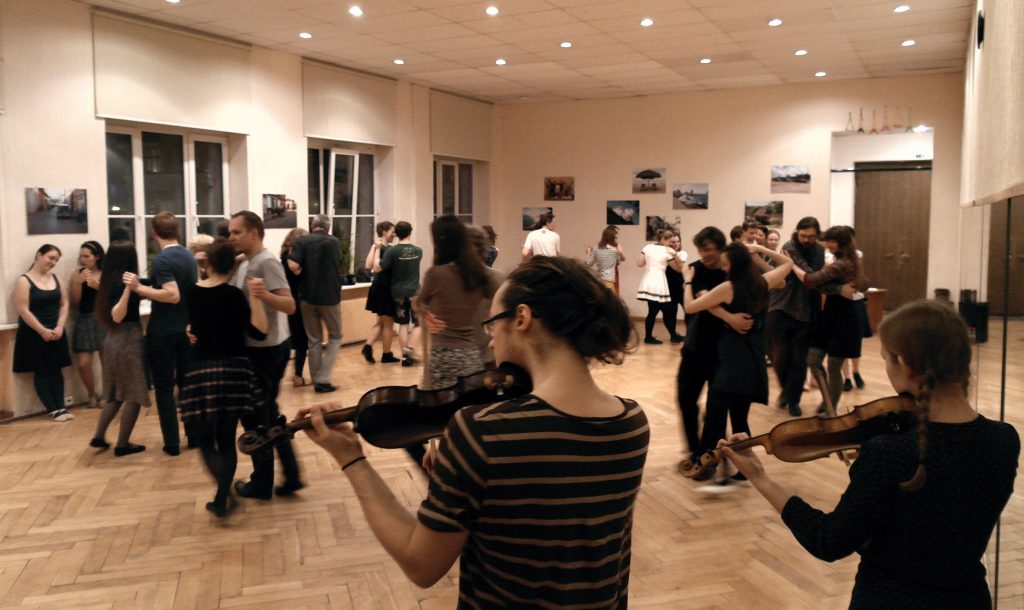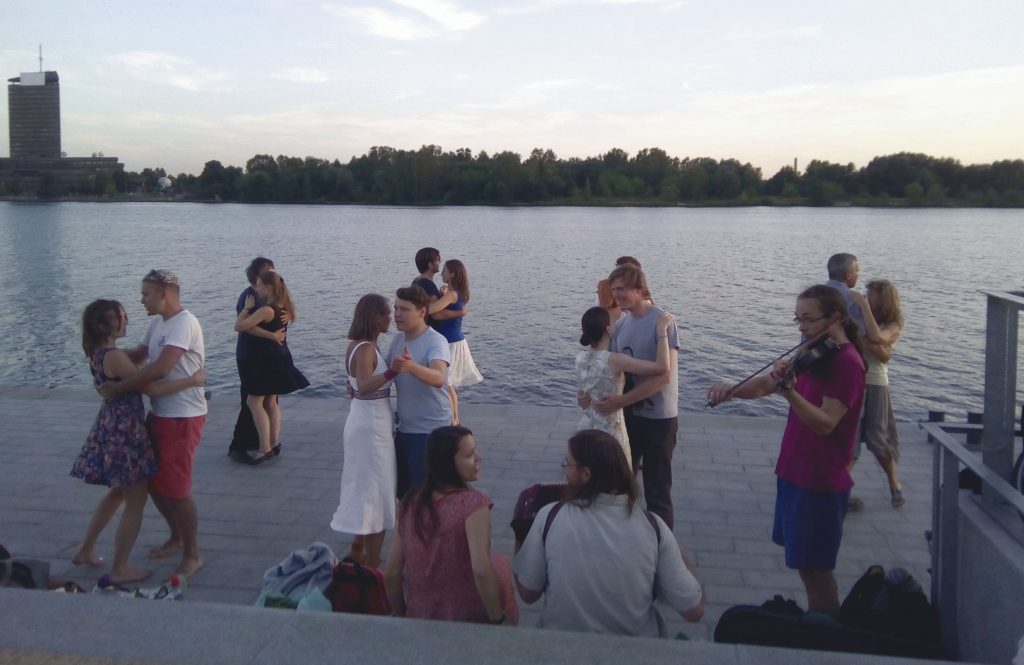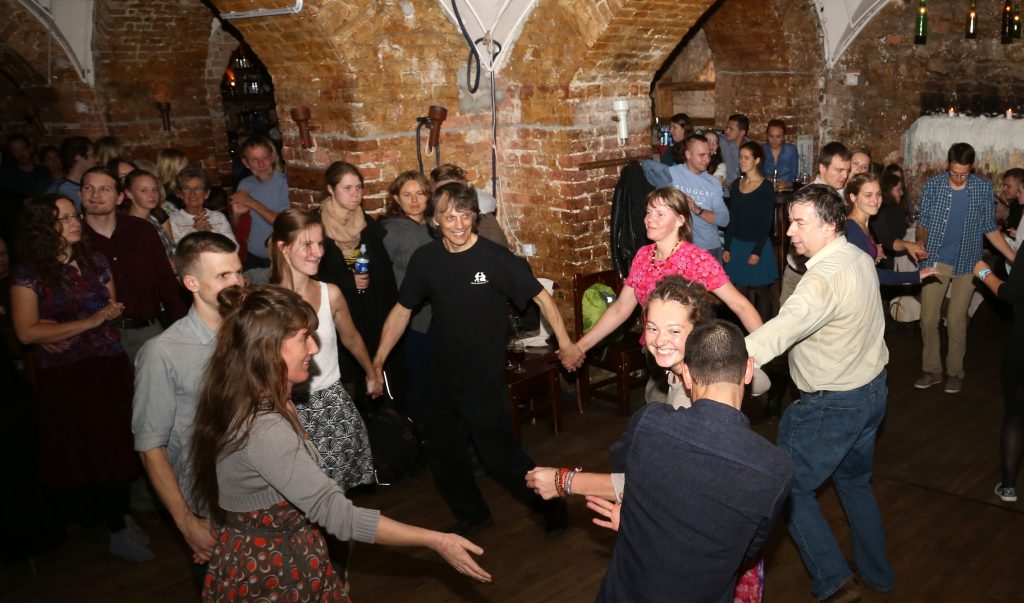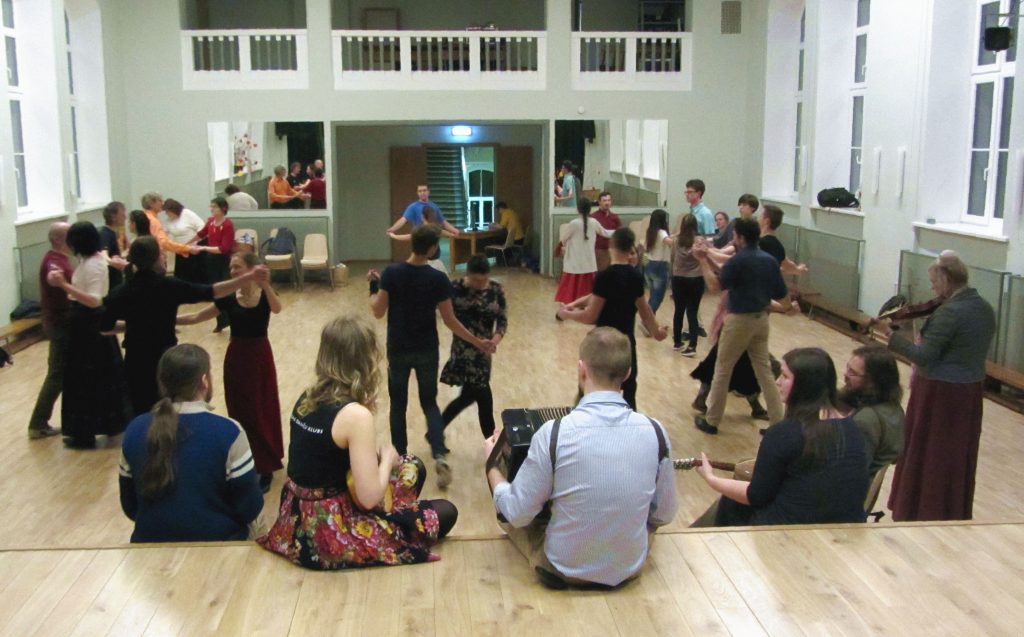Author:
Ieva Pīgozne
Other domains
Oral traditions and their expressions, including language as a vehicle of intangible cultural heritage
Social practices, rituals and festive events
Music/performing arts
Title
Dance tradition in Riga (2021)
Dancing
Dance is the term used for folk or traditional dancing in the community and beyond. It is a folk dance performed to live music for the purpose of socialising, celebrating a festival or having fun.
Geography
Riga
The tradition of dancing in Riga brings together people of all ages and professions who have knowledge and/or interest in cultural heritage, folklore, folk music and dance, as well as active leisure activities. Dancers range from people who have been actively involved for decades to people who have been involved for a shorter period of time, but keep in touch and join community activities as soon as they have the opportunity. Dancers share specific skills and knowledge, as well as a sense of community and belonging. Dancers are proud and aware that their skills, knowledge and leisure activities are special, linked to the preservation and maintenance of cultural heritage.
Overall, the community is inclusive and friendly, but as all activities are voluntary, each participant's level of activity depends on their own preferences, interests and abilities. The Riga Dance Community is not a formal organisation and therefore no records are kept of its members. The community is made up of some members of folklore groups officially active in Riga and Pierīga Region, as well as interested people and dance enthusiasts who are not active in any folklore groups, but occasionally or frequently participate in the dance evenings, festivals and camps organised by the community. The Riga dance community is made up of musicians and dancers who mostly know each other. However, not everyone knows everyone, as the most active are partly replaced every few years. Those who were active when they were young and during their studies, and then get married and become parents, often do not attend dance events for a while, then return as their children get older. Others go from being active dancers or musicians to becoming more active event organisers. In total, several thousand people have been involved in community activities over time, but those who have made friends within the community and developed better dancing and musical skills consider themselves to be part of the community. The number of participants during the events varies from one musician and a few pairs of dancers to a whole orchestra of musicians (more than 10) and several hundred dancers. The most widely attended events are festivals and dance nights, as well as camps and sometimes dance evenings. More than 200 members of the community regularly receive emails with information about the dances, but many more get their information from social networks and dance websites. Therefore, it is possible to say that the tradition of dances in Riga unites tens of active and hundreds of less active dancers, musicians, event organisers and supporters.
Importance in Community Life
The most active members of the community dance and/or play almost every day. The less active follow the activities and get involved, for example, once a month, during the annual festivities or whenever they have the opportunity. As the tradition of dances brings together musicians, dancers and event organisers (who are most often musicians and/or dancers themselves), the skills and knowledge, as well as the activities (contacting community members, meetings, events), require regular involvement, individually and with other community members. For community members, the tradition of dancing is an important part of their identity. For some it is part of or complementary to their professional activity (folklore group leaders, musicians, event organisers), for others it is a hobby. For the most active, dancing is a way of life, the community is their closest circle of friends, and belonging to this community and the tradition is an integral part of their lives. For many, maintaining the dance tradition gives them the satisfaction of contributing to the preservation of Latvian cultural heritage, encourages them to search and explore folk music and dances more deeply, and share and put what they have learned into practice, raising not only their personal level of skills and knowledge, but the overall level of the community.
Activities
The tradition of dances in Riga is a set of traditions of learning, dancing, playing and passing on traditional dances and their melodies. Folk dances are danced by groups of people to live music for socialising, celebrating festivals or for entertainment. The content of the element is composed of dances in Latvia (including local interpretations of the dances), whose choreography and musical accompaniment have occurred most often in the 19th and early 20th century, and were recorded in ethnographic or folklore collection expeditions in the 20th century or performances by dancers and musicians from neighbouring countries. Dancing music is performed on traditional musical instruments by musicians who know dance melodies. The most skilled dancers lead inexperienced dancers, who watch and repeat the dance steps. The scheduling of each dance is slightly different, as it depends on the location of musicians and dancers. In essence, dancing is a tradition-based improvisation according to the participants and the situation. The tradition of dancing includes not only dancing but also the preparation for it – search for and learning of new dances and melodies, planning, organisation events, issuing of records, documenting and studying the tradition.
Beliefs, Rituals, Unwritten Rules
The right tone is to play every dance (or its variant) only once on dance night. Mostly, for each dance, the guys ask the girls, with whom they will dance the next dance. The dancing is often commenced with the honorary step (Round Moon (Apaļais mēness), used in more solemn cases) or Mugurdancis (Riga variant of Alsunga Mugurdancis) and concludes with the long dance – the Riga dance club tradition, which has been introduced in many places. The long dance musicians tend to play in the middle of a dancing circle or walk along the dance path with the dancers.
Inheritance and transmission
Dancing and music have had a social character since their start. It is not only a family tradition but a social activity for socialising. The tradition of dancing in Riga includes learning to play the musical instruments and dancing skills of the folk music instruments, as well as the specific melodies and dance steps. It takes place on the spot during dance evenings, joining and watching more experienced Community members, as well as rehearsals and individual notes, music and dance videos.
History
For centuries, dancing is one of the activities of society for socialisation, celebrating festivals or performing rituals. Historically, the traditions of dancers have been formed in a peasant environment, interacting with the influence of the city.
In Latvia, the first records of dancing, known as jumping, is from the 16th century. By the 19th century, the tradition had already been recorded many times, including special dance events and dancing in annual festivals and family celebrations, most often weddings. Since the mid-19th century there has been evidence of dancing of cadriils, waltzes and different folk dances. At the beginning of the 20th century, dancing for fun was mainly done at green balls, evening parties, weddings, and after clean-ups. Mostly dancers were young people aged between 16 and when they married or had children. In the middle and second half of the 20th century, an increasing proportion of ballroom dances moved away from the folk dance repertoire, but following the activities of the folklore movement in the 1980s and 1990s, dances in Riga and the regular tradition of dance evenings were revived with renewed vigour. Since then, many more dances and their melodies have been obtained from the expeditions.
The tradition of dancing in Riga, in its current form, started in 1988, when the International Festival Baltica was first held in Latvia, in which several folklore groups included dances in their performances, as well as organized dancing evenings for participants of the festival. After the festival, the folklore group Savieši (then headed by Velta Leja) decided to dedicate one rehearsal every other week to dancing, and to allow the general public to attend this rehearsal. In this way, the tradition of dancing evenings took place every two weeks, which, in the mid-1990s, was taken over by the dancing club under the direction of Valda Putniņa, which remained for more than 10 years as almost the only opportunity to dance regularly in a convivial atmosphere. These dance evenings took place in the Riga 1st Gymnasium Hall, LU history and philosophy faculty, and later in the small RTU hall. Māris Jansons was the leading dance musician, Kristīne Karele, Dace Prūse and Ansis Ataols Bērziņš were also active dancers. As time passed, members of the folklore dance group Dandari were also increasingly active in the dance evenings, providing their contribution to the repertoire of dance and the dancing skills in Latgale. Ernests Spīčs was active in reconstructing dances from ancient descriptions.
In the 1990s and the first half of the 2000s, dance club dance evenings were the only regular dance evenings available to the public in Latvia, the most active participants in folklore movement from other places in Latvia. Gradually, inspired by ideas and learning from Riga dance club repertoire and experience, dance clubs were formed and dance evenings were held in Cēsis, Ogre, Kekava, Rēzekne, Koknesse, Daugavpils and elsewhere. It is thus possible to claim that the tradition of dancing in Riga has been a source of inspiration for the whole dancing movement in Latvia. To a large extent, it is still.
Until 1999, the informal name of the Riga dance community was the Dance Club, because that's what the dance evenings were called. When the most active dancers formed a dance set and started to participate in folklore festivals, the Riga dancing club (RDK) became the name of the folklore group. This transition is the basis for the uncertainties arising from the folklore set (RDK), dancing or dance evening and the Community name. Since this transition, the Riga dancing Community, which is much wider than THE RDK, does not have a single name.
It is important to emphasise that popular dance repertoire has never been "purely Latvian" in the history of Latvian dance. The names of the dances recorded in the 19th century often indicate dances of French, Swedish, Russian and other peoples, and records show that, as early as the mid-19th century, waltzes, quadrilles and other dances known to foreigners (mentioned in diaries by Anders Sjögren during the expedition of the Liv bank, as well as Julius Döring, during a visit to Dundaga Manor). The dance history researcher Sandis Zučiks, studying dance origin, often came to the conclusion that the so-called Latvian dances have their true origin outside the borders of our country, and often, since their emergence, these dances have started to acquire local variations in Latvia after just a few years. Fairy-tale researchers and researchers of the history of clothing have come to similar conclusions, i.e., there has always been contact, interaction and constant development, and there are more similarities between different cultural and historical regions and also with territories outside Latvia, than there are differences. The assumption of a single origin in folklore and significant regional and national differences in ethnography originated in the early stages of these fields of research, was popularised in the process of nation-building in the 19th century, and later skillfully used for ideological purposes to strengthen the identity of nation-states until World War II. These insights are now being revisited and corrected or even discarded altogether in scholarly research.
Today, it is the dance traditions that continue to maintain the skills and repertoire of dancing and playing musical instruments that reflect the cultural and historical heritage of Latvia's folk dance traditions. The Riga dance tradition is manifested in situations and ways that are typical of the tradition, but adapted to the times and the environment. Accordingly, the old dances continue to be danced to (mostly) live music, dances can be booked, boys ask girls, and often not only dancers but also musicians join in. There is also a new emergence of learning dances in rehearsals, from internet videos, in large halls and at corporate events. Dancers are no longer just young people, but people of all ages. Despite all the innovations, the tradition of dancing in Riga maintains the boundaries between dancing folk dances (the social context, repertoire and aesthetics of traditions) and other forms of dancing in society, and thus constitutes a direct continuation of the folk dance tradition. It is important that a wide range of dance styles are available today and therefore dancing is a conscious choice that is often based on Latvian cultural heritage. Often, especially among young people, dancing is a first step towards understanding, learning and practicing folk traditions with family and friends, during celebrations and everyday life.
In the 21st century, dances have become increasingly popular, as evidenced by the inclusion of even a small number of the best-known dances in the repertoire of many adult and especially children's folklore groups throughout Latvia. Ilga Reizniece, Raitis Sondors, Anastasija Oļenkina, Ieva Mūrniece, Oskars Patjanko, Māra Raģe, Katrīna Dimanta and many other musicians and their associations have joined the ranks of dance musicians. The tradition of dancing in Riga has been able to grow from one dancing evening every two weeks to the fact that the dance evenings were not only under the auspices of the RDK and the Traditional Culture Center, but also under the direction of other organizers, such as the series of events "Dances of the Year in Four Tours" at the Riga Culture and Leisure Centre "Imanta" by the dance music group Trejdevini, dance evenings at Violiskunis, by Ansis Ataols Bērziņš, dances at the outdoor recreation park Egle, as well as weekly dance evenings at the Folklub Ala. Not only the offer of dance evenings grew, but also the dance repertoire. While 20 years ago the repertoire of musicians and dancers usually included about 10-30 Latvian, Lithuanian and Estonian dances known from the mid-19th to early 20th century, now at least 50 different dances are regularly performed at RDK dance evenings, while the repertoire of musicians and more skilled dancers includes several hundred dances and their melodies, not only from the Baltic states, but also from Belarus, Russia, Hungary, Germany, France and other countries. It should be stressed here that dances from other countries only become part of the repertoire if they are part of the dance tradition, as Salsa, hip hop or other popular dances of today are never danced on dance nights. Instead, there is an active replenishment of the repertoire, acquiring the dances given by the speakers, looking for melodies and dance records in the Latvian folklore storage archives and performing reconstructing them, as well as learning the dances of neighbouring nations at international dance festivals and camps.
The tradition of dancing in Riga is a good example of how a tradition lives and develops. This is visible not only in the growing number of participants and the replacement of the most active members, but also in the development of the repertoire, i.e. the dances that musicians and dancers like are becoming more popular and popular. Many dances are learned in dance camps and rehearsals, with a special emphasis on dances that have been recorded in Latvia, but not all of them are popular. There are also Community groups or groups of friends in which some dances are more popular than others. However, it is never forgotten that not only the new, but also the existing, known and more widely known dancing repertoire must be taken into account. In addition, it should be stressed that the unifying factors of the community are not only the dance repertoire, but also the style of dancing and the traditions of the dance evenings, the live accompaniment and the interplay of musicians and dancers according to the situation.
Additional Information
The dance tradition in Riga, which is based on traditional musical instruments and dancing, exposure to skills and knowledge in a number of other traditional cultural areas: the celebration of annual festivals and family honours, the making of musical instruments, the historical clothing and its imitation, such as home-made pastilles used for dancing.
Masters
The Community is large and has many significant musicians, dancers, new participants, event organisers and researchers. Bright examples include:
Ilga Reizniece – plays and teaches dance, Raitis Sondors – plays and dances, Anastasija Oļenkina – plays and dances, Dace Circene – plays, dances, organises events, Dina Liepa – plays and trains youth, organises events, Dace Prūse – plays and teaches traditional singing, Ieva Mūrniece – plays and organises events, Jānis Zemgus Jātnieks – plays and dances, Inga Holsta – dances and teaches dance, organises events, Jevgēnijs Mickevičs – dances and organises events, Sandis Zučiks – dances and explores the history of dance, works on folkdance.lv, Ieva Pīgozne – dances, organises events and explores the dance tradition.
Institutions and Organizations
The Traditional Culture Centre, Danču krātuve, Ritums Culture and Folk Art Centre and its affiliated folklore groups, especially the Riga Dance Club, Dandari Folklore Dance Group of the University of Latvia, Kokle Folklore Group of the Riga School Children and Youth Centre, the Zeiradi Society and the Zeidi Friends Group.
Strengthening the Tradition
In the past 30 years, it is possible to say that hundreds of events have been organised: many dance clubs, dance evenings, dance nights, festivals, camps, dancing – both separately and as an essential part of other events. From the late 1990s onward, dance music albums, dance descriptions and videos were recorded and released.
Funding for dance evenings, dance nights, festivals, camps, dance events, dance descriptions and video publication to date have been received from the State Culture Capital Foundation, the Latvian Foundation and other, mostly local government budgets. Similarly, the funding of the organisers and the funding they raise have been used. Co-financing with community members is often used, as well as volunteer activities and projects.
From the late 1980s onwards, the dance tradition in Riga has experienced a huge increase in popularity. The dance community has become stronger in Riga. It brings together several generations of musicians and dancers. Not only did the number and skills of the dancers and musicians increase, but also general public awareness of dances. Dances in Riga have become one of the most popular traditional cultural activities recognised by the broader community. Dance descriptions, video publications and Internet resources provide an opportunity to learn or repeat them outside organised events or rehearsals.
The largest financing for the maintenance and development of the dance traditions in Riga to date, and will continue to be, is in the form of projects from the State Culture Capital Fund, as well as in competitions of Riga City Council's cultural projects. The support of Riga City Council has so far also been received indirectly, namely through the provision of folklore performances and their activities (premises, transport), where the training of traditional musical instruments and dancers takes place. The Latvian Foundation has also supported the dance archive projects so far, it is planning to continue to participate in Latvian Fund cultural projects. In addition to all the above-mentioned support, the Community actors with their enthusiasm, participation and volunteering are provided.
Continuity/Development
For the wider public to be informed and in support of the community – to maintain the Folkdance website on dancing events and the archive of dances and their melodies; to organise publicity activities through the opportunities offered by modern technologies and social networks, to cooperate more closely with the media.
Similar to many folklore genres and traditional cultural phenomena, research has so far focused on exploring the object – the collection and research of dance choreographs and melodies. Nowadays, the focus of research includes the study of the subject, i.e., the study of the bearers of the tradition at the time of the performance of the tradition, its context and its social aspects. It will therefore continue to explore the tradition of dancing in Riga by gathering information on current dance practices and context, as well as capturing the manifestations of the tradition today, paying attention to who dances and plays, at what moments, how dances are learned, how the repertoire of favourite dances develops and changes, the prestige, image and role of dances in society, as well as other aspects.
Responsible for the history of dancers and dancing, including the tradition of dancing in Riga: the association Danču krātuve, and in particular Sandis Zučiks, and the association Traditional Culture Centre, in particular Ieva Pīgozne and Valdis Putniņš.
Organised dance events: evening, nights, festivals. Organised dance camps, masters, dance training video materials. The dance archive website is maintained and regularly supplemented with a database of publicly available dances, their description, melodies, methodological materials, lectures and research results. Exchange of information with the calendar of events and the discussion platform for the coordination of opinions and addressing topical issues. Inclusion in the National Intangible Cultural Heritage List of Latvia has been acquired.
The Traditional Cultural Centre and Danču krātuve are the main organisers and continue to organise dance evenings, festivals and camps, as well as training and the production of dance music and video recordings, with the involvement of or in cooperation with folklore groups or friends' associations “Rīgas Danču klubs”, “Dandari”, “Kokle”, “Banga”, “Zeidi”, “Brička”, “Teikas muzikanti”, “Pupa”, “Baltava”, Ilga Reizniece, Daci Prūsis, Raitis Sondors, Sandra and Ilmārs Pumpurs, etc. There are also other members of the dancing movement who organise dance evenings or dance training, such as Lily and Edgars Lipori and Trejdeviņi, and the Jasukovich family association “Radi”. Most of the community mentioned here have implemented projects for the maintenance and promotion of dancing traditions and will continue to do so by participating in the national Cultural Capital Foundation, the Latvian Foundation, and Riga City Council's cultural projects and other competitions, as well as self-financing and volunteering.
The planned activities will be carried out to maintain and develop the tradition of dancing in Riga, to research and promote it, to strengthen the community, to ensure regular practice of dancing and playing, to provide training in dancing and music making, including the updating of training materials. The inclusion of the dancing tradition in the National Intangible Cultural Heritage List of Latvia will help to achieve the above objectives and obtain more funding to support them, as well as to consolidate the tradition of dances in the Song Festival tradition and gain more visibility and support at the national level.
Threats to the Tradition
For many, dancing is mainly entertainment, and there is a lack of knowledgeable and skilled dance instructors and especially musicians. The preparation of such “upper-class specialists” does not take place in any camp or courses, it is something that individual, dedicated and motivated people become, learning from their own and others' experiences over the years. In order to avoid stagnating the tradition, particular attention should be paid to its development not only in breadth but also in quality, which would require support for the training of skilled dance musicians and dance instructors.
The tradition of dances cannot develop if there are restrictions on meetings. The country's crises also affect people's leisure habits. After difficult times, the tradition always requires recovery by investing in the promotion and performance of additional works.
Applicant
Society “Traditional Cultural Centre”
Photo Gallery
Video Materials
Text Materials
Publications
Juris A. (1921) Latvian People's music materials. Book 5. Dance. Riga: Latv. Cultural Foundation.
Moss H. (1966) Latvian games and toys. Riga: Zinātne.
Silina E. (1982) The origin and development of Latvian People's dance. Riga: Avots.
Moss H. (1991) Latvian domestic choreography. Riga: Zinātne.
Spīčs E. (1999-2000) Martin's dance book 1-3. Riga: LU.
Pucena S., Vītola I. (2018) Green balls. [Aizpute]: interdisciplinary art group Serde.
Websites
Dancing storage - The page contains and is supplemented with information about dancers: video, music, notes, interviews, publications. Search functions by card, dance names, number of dancers, etc.
Folkdance - information on the dancing measures, calendar. Information on the history of the Riga dancing club and the dancing movement.

